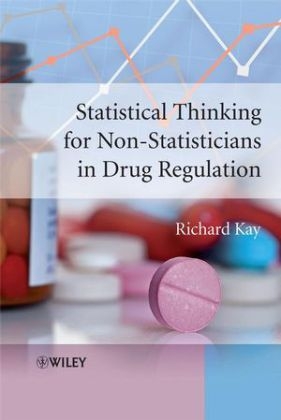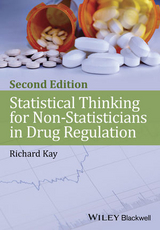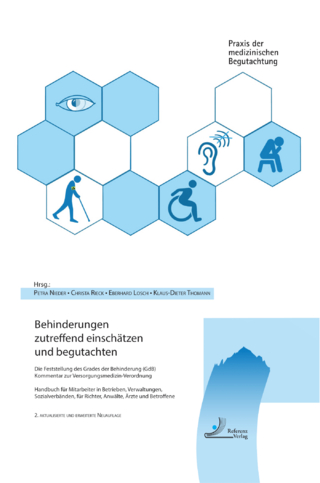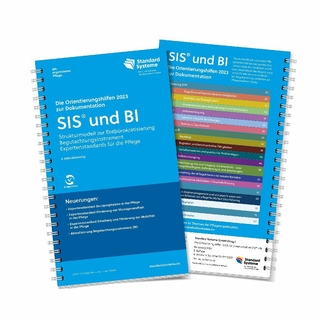
Statistical Thinking for Non Statisticians in Drug Regulation
Wiley-Blackwell (Verlag)
978-0-470-31971-0 (ISBN)
- Titel ist leider vergriffen;
keine Neuauflage - Artikel merken
Statistical Thinking for Clinical Trials in Drug Regulation:* Assists pharmaceutical personnel in communicating effectively with statisticians using statistical language* Improves the ability to read and understand statistical methodology in papers and reports and to critically appraise that methodology* Helps to understand the statistical aspects of the regulatory framework better quoting extensively from regulatory guidelines issued by the EMEA (European Medicines Evaluation Agency), ICH (International Committee on Harmonization and the FDA (Food and Drug Administration)
Richard Kay. PhD Medical Statistics. The author worked within academia until 1989 when he set up his own company offering statistics and data management services to the pharmaceutical industry. Since 2005, he works as an Independent Statistical Consultant providing full consultancy and training course service to the Pharmaceutical and Medical Device industries. The author currently lectures and runs courses for the pharmaceutical industry in all major European countries: UK, France, Ireland, Belgium, The Netherlands, Germany, Spain, Italy, Switzerland, Sweden, Denmark, Russia and South Africa and US. His lectures are predominantly given within Pharma Cos or CROs.
Preface. Abbreviations. 1 Basic ideas in clinical trial design. 1.1 Historical perspective. 1.2 Control groups. 1.3 Placebos and blinding. 1.4 Randomisation. 1.4.1 Unrestricted randomisation. 1.4.2 Block randomisation. 1.4.3 Unequal randomisation. 1.4.4 Stratified randomisation. 1.4.5 Central randomisation. 1.4.6 Dynamic allocation and minimisation. 1.4.7 Cluster randomisation. 1.5 Bias and precision. 1.6 Between- and within-patient designs. 1.7 Cross-over trials. 1.8 Signal and noise. 1.8.1 Signal. 1.8.2 Noise. 1.8.3 Signal-to-noise ratio. 1.9 Confirmatory and exploratory trials. 1.10 Superiority, equivalence and non-inferiority trials. 1.11 Data types. 1.12 Choice of endpoint. 1.12.1 Primary variables. 1.12.2 Secondary variables. 1.12.3 Surrogate variables. 1.12.4 Global assessment variables. 1.12.5 Composite variables. 1.12.6 Categorisation. 2 Sampling and inferential statistics. 2.1 Sample and population. 2.2 Sample statistics and population parameters. 2.2.1 Sample and population distribution. 2.2.2 Median and mean. 2.2.3 Standard deviation. 2.2.4 Notation. 2.3 The normal distribution. 2.4 Sampling and the standard error of the mean. 2.5 Standard errors more generally. 2.5.1 The standard error for the difference between two means. 2.5.2 Standard errors for proportions. 2.5.3 The general setting. 3 Confidence intervals and p-values. 3.1 Confidence intervals for a single mean. 3.1.1 The 95 per cent confidence interval. 3.1.2 Changing the confidence coefficient. 3.1.3 Changing the multiplying constant. 3.1.4 The role of the standard error. 3.2 Confidence intervals for other parameters. 3.2.1 Difference between two means. 3.2.2 Confidence intervals for proportions. 3.2.3 General case. 3.3 Hypothesis testing. 3.3.1 Interpreting the p-value. 3.3.2 Calculating the p-value. 3.3.3 A common process. 3.3.4 The language of statistical significance. 3.3.5 One-tailed and two-tailed tests. 4 Tests for simple treatment comparisons. 4.1 The unpaired t-test. 4.2 The paired t-test. 4.3 Interpreting the t-tests. 4.4 The chi-square test for binary data. 4.4.1 Pearson chi-square. 4.4.2 The link to a signal-to-noise ratio. 4.5 Measures of treatment benefit. 4.5.1 Odds ratio (OR). 4.5.2 Relative risk (RR). 4.5.3 Relative risk reduction (RRR). 4.5.4 Number needed to treat (NNT). 4.5.5 Confidence intervals. 4.5.6 Interpretation. 4.6 Fisher's exact test. 4.7 The chi-square test for categorical and ordinal data. 4.7.1 Categorical data. 4.7.2 Ordered categorical (ordinal) data. 4.7.3 Measures of treatment benefit for categorical and ordinal data. 4.8 Extensions for multiple treatment groups. 4.8.1 Between-patient designs and continuous data. 4.8.2 Within-patient designs and continuous data. 4.8.3 Binary, categorical and ordinal data. 4.8.4 Dose ranging studies. 4.8.5 Further discussion. 5 Multi-centre trials. 5.1 Rationale for multi-centre trials. 5.2 Comparing treatments for continuous data. 5.3 Evaluating homogeneity of treatment effect. 5.3.1 Treatment-by-centre interactions. 5.3.2 Quantitative and qualitative interactions. 5.4 Methods for binary, categorical and ordinal data. 5.5 Combining centres. 6 Adjusted analyses and analysis of covariance. 6.1 Adjusting for baseline factors. 6.2 Simple linear regression. *6.3 Multiple regression. 6.4 Logistic regression. 6.5 Analysis of covariance for continuous data. 6.5.1 Main effect of treatment. 6.5.2 Treatment-by-covariate interactions. *6.5.3 A single model. 6.5.4 Connection with adjusted analyses. 6.5.5 Advantages of analysis of covariance. 6.6 Binary, categorical and ordinal data. 6.7 Regulatory aspects of the use of covariates. *6.8 Connection between ANOVA and ANCOVA. 6.9 Baseline testing. 7 Intention-to-treat and analysis sets. 7.1 The principle of intention-to-treat. 7.2 The practice of intention-to-treat. 7.2.1 Full analysis set. 7.2.2 Per-protocol set. 7.2.3 Sensitivity. 7.3 Missing data. 7.3.1 Introduction. 7.3.2 Complete cases analysis. 7.3.3 Last observation carried forward (LOCF). 7.3.4 Success/failure classification. 7.3.5 Worst case/best case imputation. 7.3.6 Sensitivity. 7.3.7 Avoidance of missing data. 7.4 Intention-to-treat and time-to-event data. 7.5 General questions and considerations. 8 Power and sample size. 8.1 Type I and type II errors. 8.2 Power. 8.3 Calculating sample size. 8.4 Impact of changing the parameters. 8.4.1 Standard deviation. 8.4.2 Event rate in the control group. 8.4.3 Clinically relevant difference. 8.5 Regulatory aspects. 8.5.1 Power > 80 per cent. 8.5.2 Powering on the per-protocol set. 8.5.3 Sample size adjustment. 8.6 Reporting the sample size calculation. 9 Statistical significance and clinical importance. 9.1 Link between p-values and confidence intervals. 9.2 Confidence intervals for clinical importance. 9.3 Misinterpretation of the p-value. 9.3.1 Conclusions of similarity. 9.3.2 The problem with 0.05. 10 Multiple testing. 10.1 Inflation of the type I error. 10.2 How does multiplicity arise. 10.3 Regulatory view. 10.4 Multiple primary endpoints. 10.4.1 Avoiding adjustment. 10.4.2 Significance needed on all endpoints. 10.4.3 Composite endpoints. 10.4.4 Variables ranked according to clinical importance. 10.5 Methods for adjustment. 10.6 Multiple comparisons. 10.7 Repeated evaluation over time. 10.8 Subgroup testing. 10.9 Other areas for multiplicity. 10.9.1 Using different statistical tests. 10.9.2 Different analysis sets. 11 Non-parametric and related methods. 11.1 Assumptions underlying the t-tests and their extensions. 11.2 Homogeneity of variance. 11.3 The assumption of normality. 11.4 Transformations. 11.5 Non-parametric tests. 11.5.1 The Mann-Whitney U-test. 11.5.2 The Wilcoxon signed rank test. 11.5.3 General comments. 11.6 Advantages and disadvantages of non-parametric methods. 11.7 Outliers. 12 Equivalence and non-inferiority. 12.1 Demonstrating similarity. 12.2 Confidence intervals for equivalence. 12.3 Confidence intervals for non-inferiority. 12.4 A p-value approach. 12.5 Assay sensitivity. 12.6 Analysis sets. 12.7 The choice of. 12.7.1 Bioequivalence. 12.7.2 Therapeutic equivalence. 12.7.3 Non-inferiority. 12.7.4 The 10 per cent rule for cure rates. 12.7.5 Biocreep and constancy. 12.8 Sample size calculations. 12.9 Switching between non-inferiority and superiority. 13 The analysis of survival data. 13.1 Time-to-event data and censoring. 13.2 Kaplan-Meier (KM) curves. 13.2.1 Plotting KM curves. 13.2.2 Event rates and relative risk. 13.2.3 Median event times. 13.3 Treatment comparisons. 13.4 The hazard ratio. 13.4.1 The hazard rate. 13.4.2 Constant hazard ratio. 13.4.3 Non-constant hazard ratio. 13.4.4 Link to survival curves. *13.4.5 Calculating KM curves. *13.5 Adjusted analyses. 13.5.1 Stratified methods. 13.5.2 Proportional hazards regression. 13.5.3 Accelerated failure time model. 13.6 Independent censoring. 13.7 Sample size calculations. 14 Interim analysis and data monitoring committees. 14.1 Stopping rules for interim analysis. 14.2 Stopping for efficacy and futility. 14.2.1 Efficacy. 14.2.2 Futility and conditional power. 14.2.3 Some practical issues. 14.2.4 Analyses following completion of recruitment. 14.3 Monitoring safety. 14.4 Data Monitoring Committees. 14.4.1 Introduction and responsibilities. 14.4.2 Structure. 14.4.3 Meetings and recommendations. 14.5 Adaptive designs. 14.5.1 Sample size re-evaluation. 14.5.2 Flexible designs. 15 Meta-analysis. 15.1 Definition. 15.2 Objectives. 15.3 Statistical methodology. 15.3.1 Methods for combination. 15.3.2 Confidence Intervals. 15.3.3 Fixed and random effects. 15.3.4 Graphical methods. 15.3.5 Detecting heterogeneity. 15.3.6 Robustness. 15.4 Ensuring scientific validity. 15.4.1 Planning. 15.4.2 Publication bias and funnel plots. 15.5 Meta-analysis in a regulatory setting. 15.5.1 Retrospective analyses. 15.5.2 One pivotal study. 16 The role of statistics and statisticians. 16.1 The importance of statistical thinking at the design stage. 16.2 Regulatory guidelines. 16.3 The statistics process. 16.3.1 The Statistical Methods section of the protocol. 16.3.2 The statistical analysis plan. 16.3.3 The data validation plan. 16.3.4 The blind review. 16.3.5 Statistical analysis. 16.3.6 Reporting the analysis. 16.3.7 Pre-planning. 16.3.8 Sensitivity and robustness. 16.4 The regulatory submission. 16.5 Publications and presentations. References. Index.
| Erscheint lt. Verlag | 1.10.2007 |
|---|---|
| Zusatzinfo | Illustrations |
| Verlagsort | Hoboken |
| Sprache | englisch |
| Maße | 177 x 244 mm |
| Gewicht | 632 g |
| Einbandart | gebunden |
| Themenwelt | Medizin / Pharmazie |
| Technik | |
| ISBN-10 | 0-470-31971-2 / 0470319712 |
| ISBN-13 | 978-0-470-31971-0 / 9780470319710 |
| Zustand | Neuware |
| Informationen gemäß Produktsicherheitsverordnung (GPSR) | |
| Haben Sie eine Frage zum Produkt? |
aus dem Bereich



